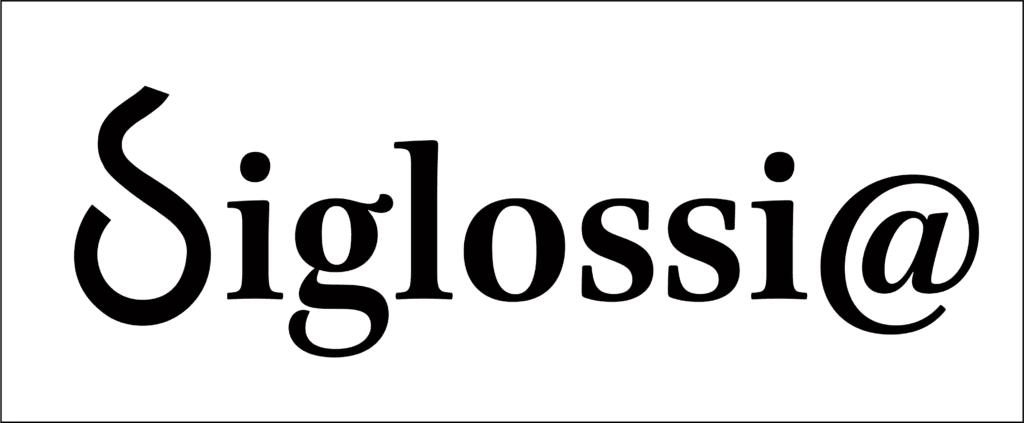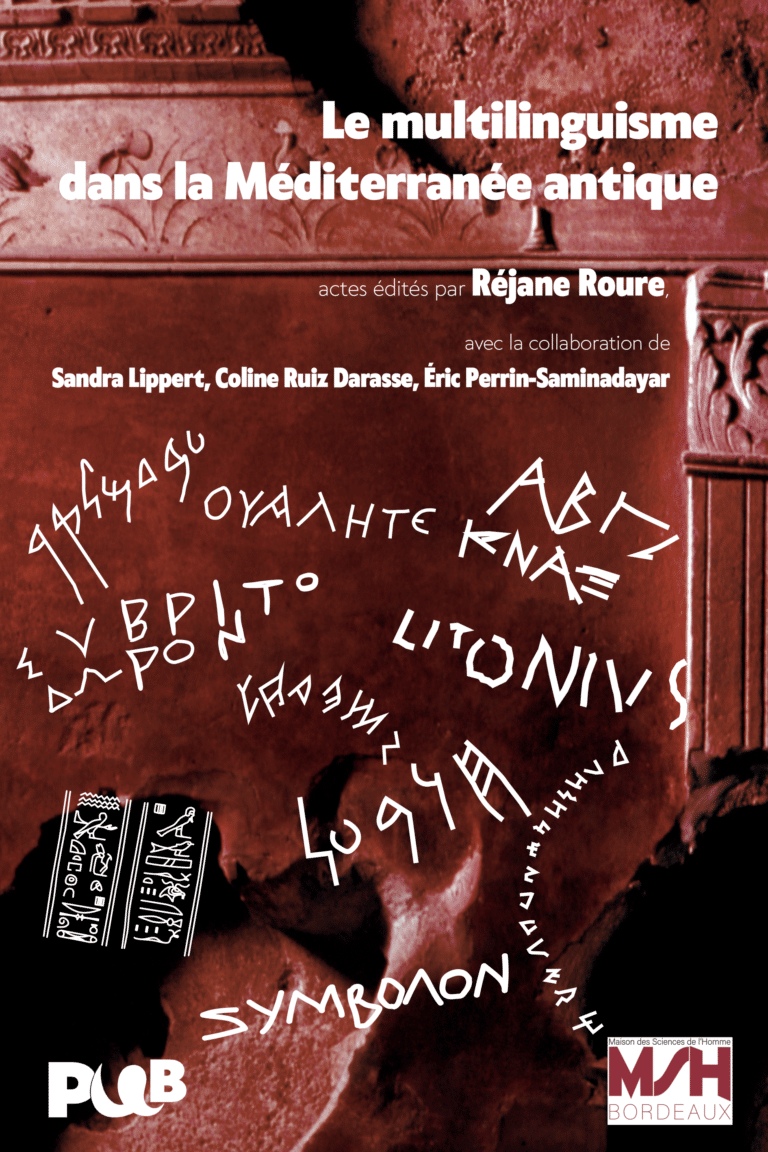The following paper is based on the documentation gathered in the Leuven database Trismegistos [https://www.trismegistos.org/index.php], which lists about 50,000 documentary texts from Egypt (in all languages on all kinds of writing materials) dated between the third century BC and the third century AD [only texts dated within a maximum date span 200 years are taken into account]. Bilingual Greek-demotic documents constitute about 5 % of the total [2626 texts, accessed August 2016]1.
Chronological spread of the documentation by century2
| BC3 | BC2 | BC1 | AD1 | AD2 | AD3 | |
| Greek | 5397 | 4819 | 2602 | 6467 | 19698 | 12598 |
| Demotic | 1728 | 2506 | 1392 | 1244 | 469 | 177 |
| Bilingual | 362 | 318 | 160 | 258 | 603 | 744 |
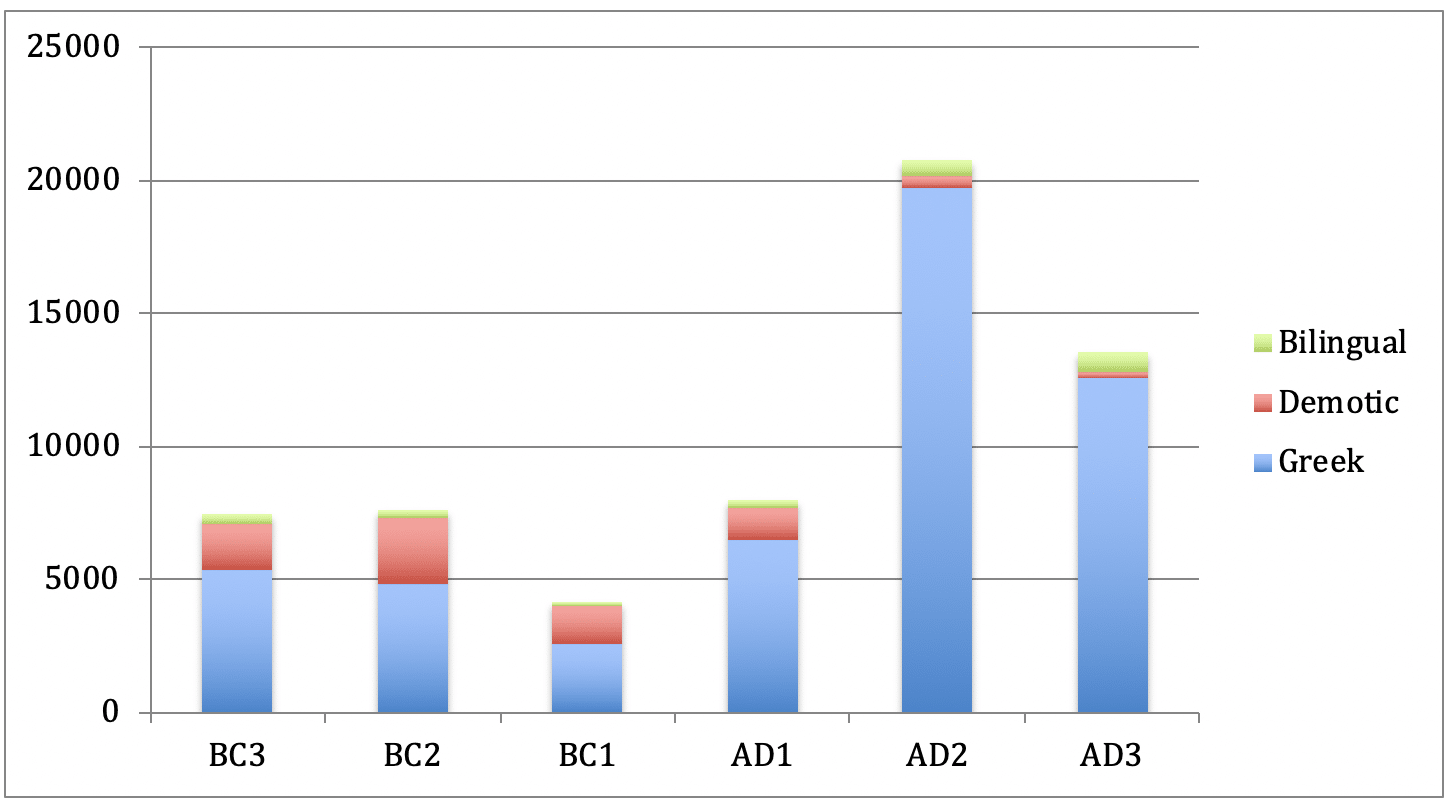
Figure 1 shows the predominance of Greek and the uneven spread of documents written in Greek over the centuries, with a slump in the first century BC (and the first half of the first century AD).
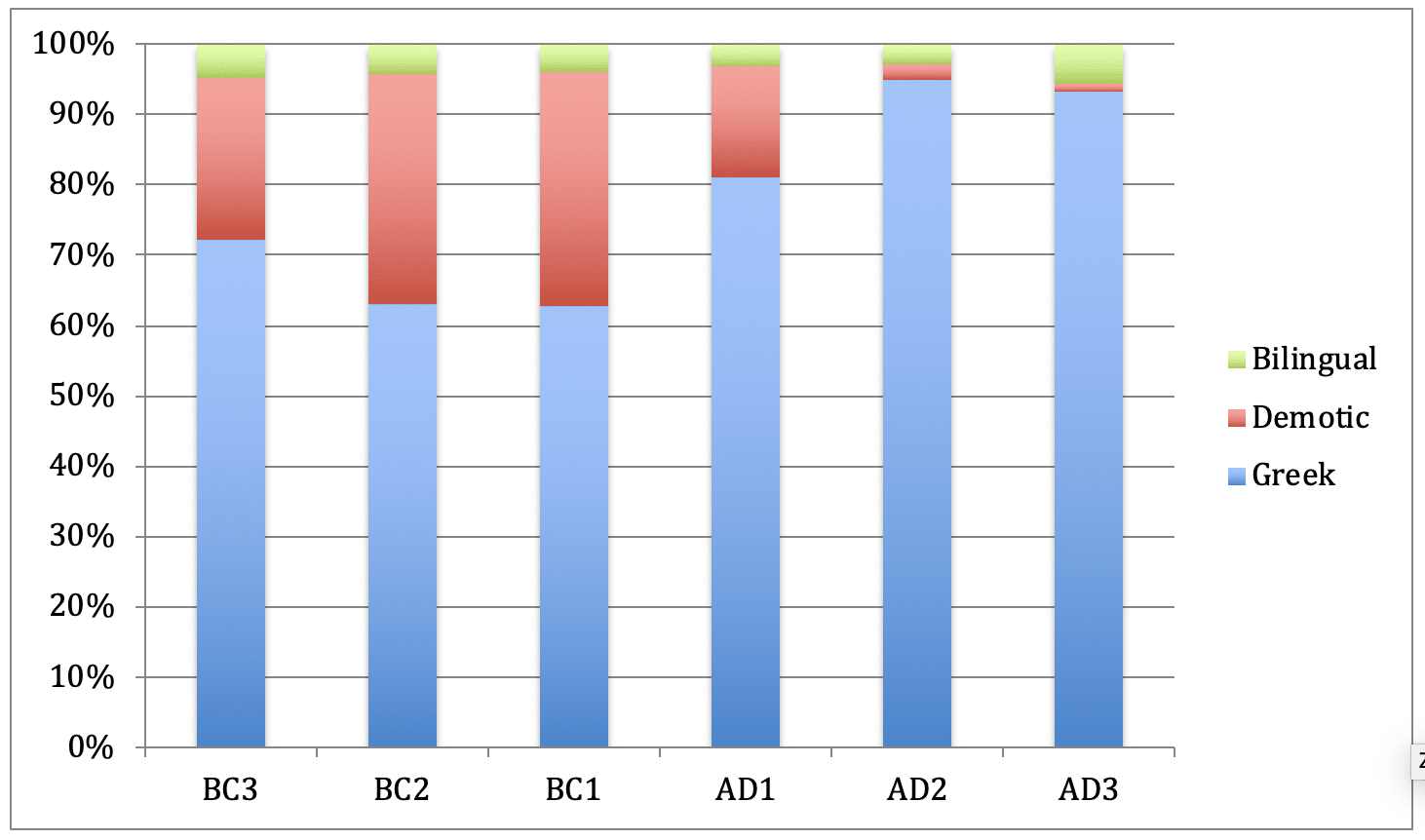
Greek documents form a clear majority over the whole period (partly because a larger percentage of Greek texts has been published and included in TM) The presence of demotic texts increases in the later Ptolemaic period, but demotic all but disappears in the second century AD. Bilingual documents form a small group (never more than 5 %), but their numbers increase somewhat in the third century AD, when demotic is usually accompanied by Greek. The reason for this unexpected rise is the survival of hundreds of bilingual mummy labels, which are usually dated to the late second or early third century3.
Clearly demotic, before disappearing almost completely in the course of the third century AD, is more and more accompanied by Greek.
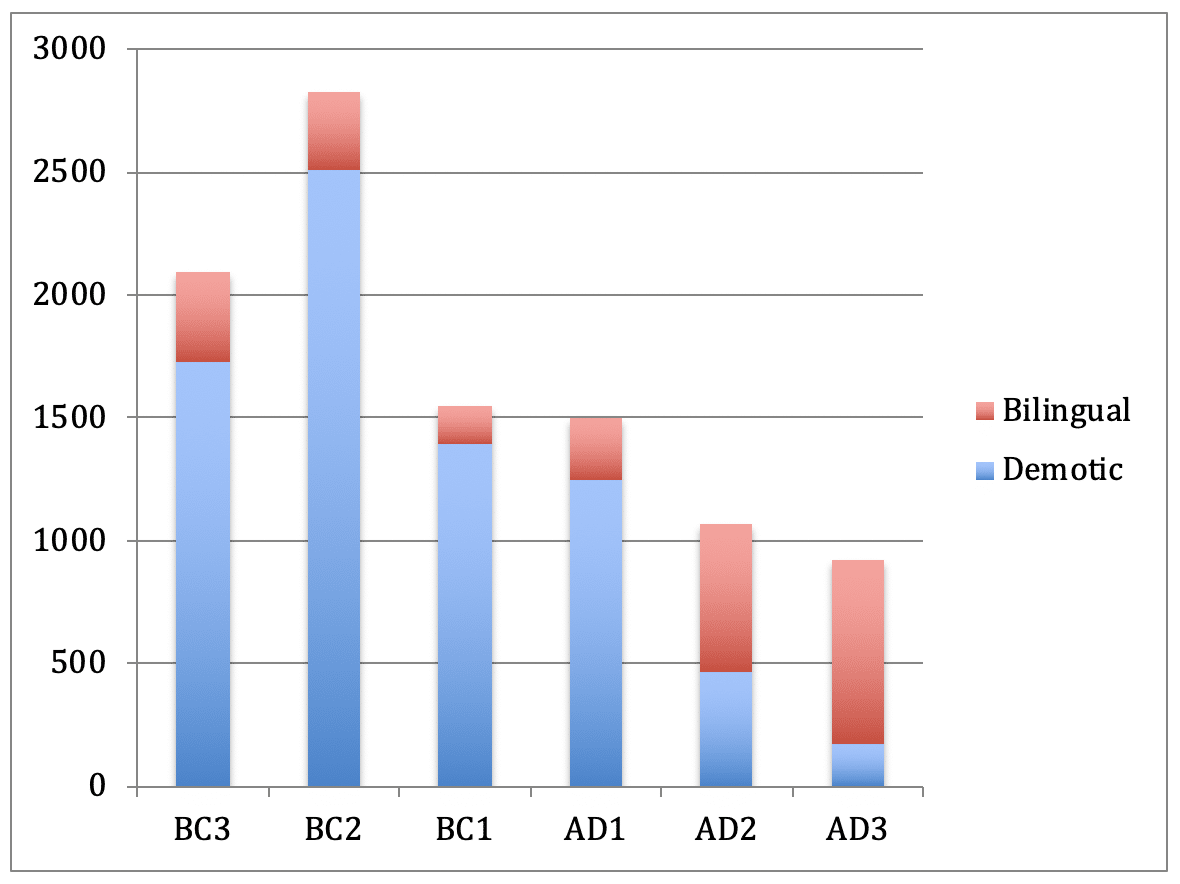
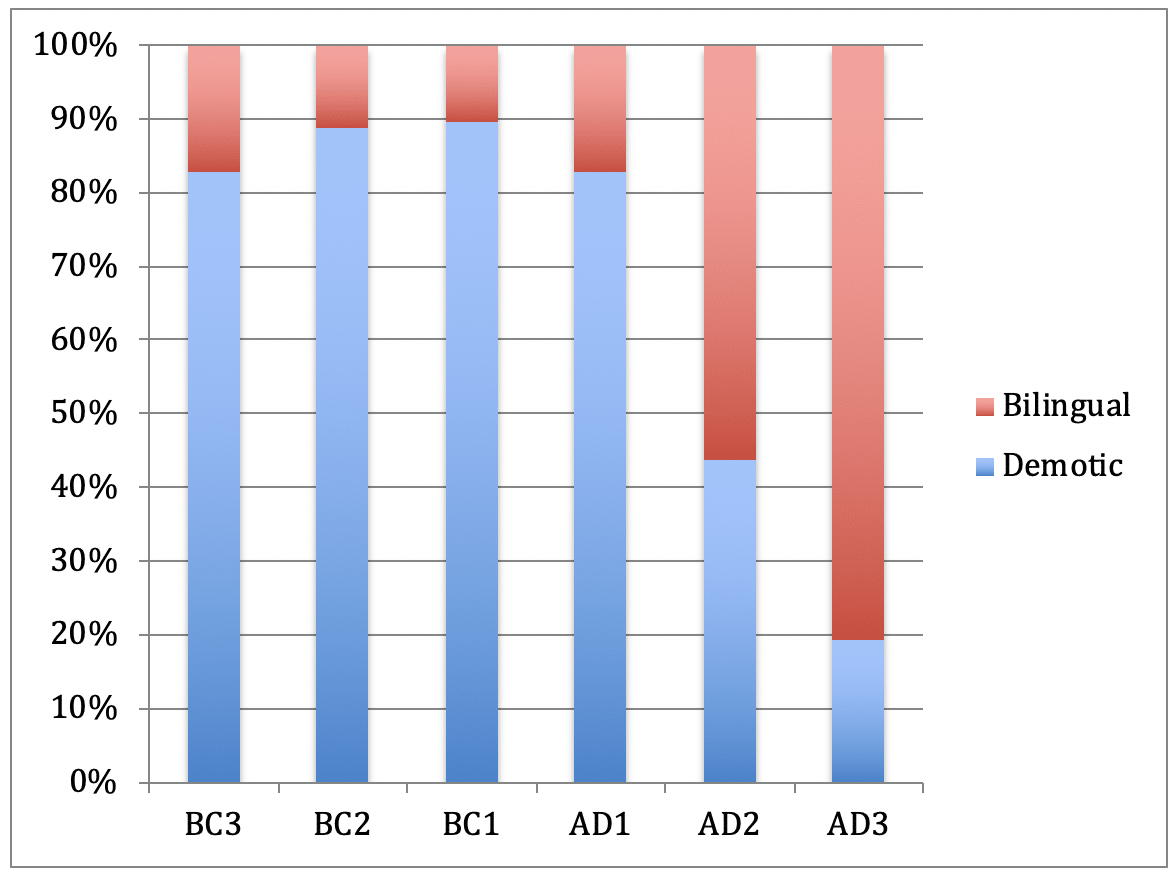
Writing material
The figures are very diverse: Greek peaks in the second century AD with 11,000 texts, demotic in the second century BC with 1100 texts and bilinguals in the third century AD with 600 texts. Therefore the differences come out better if the chronological spread is presented in terms of percentages, as in graphs 5a-c below. Most Greek texts are written on papyrus, throughout the whole period; ostraca come second and wood a distant third. For demotic, ostraca take first place, mainly because hundreds of tax receipts have been published in the past (tax receipts are formulaic and therefore easier to read for editors), whereas thousands of more difficult papyri (letters, accounts and lists) are still awaiting publication. With the bilinguals (and in part also for demotic) the picture of the Roman period is distorted, since the only texts that remain are ostraca from Narmuthis and mummy labels. These may be in either Greek or demotic, but many of them are bilingual and hardly any other demotic documentary texts survive from the third century AD.
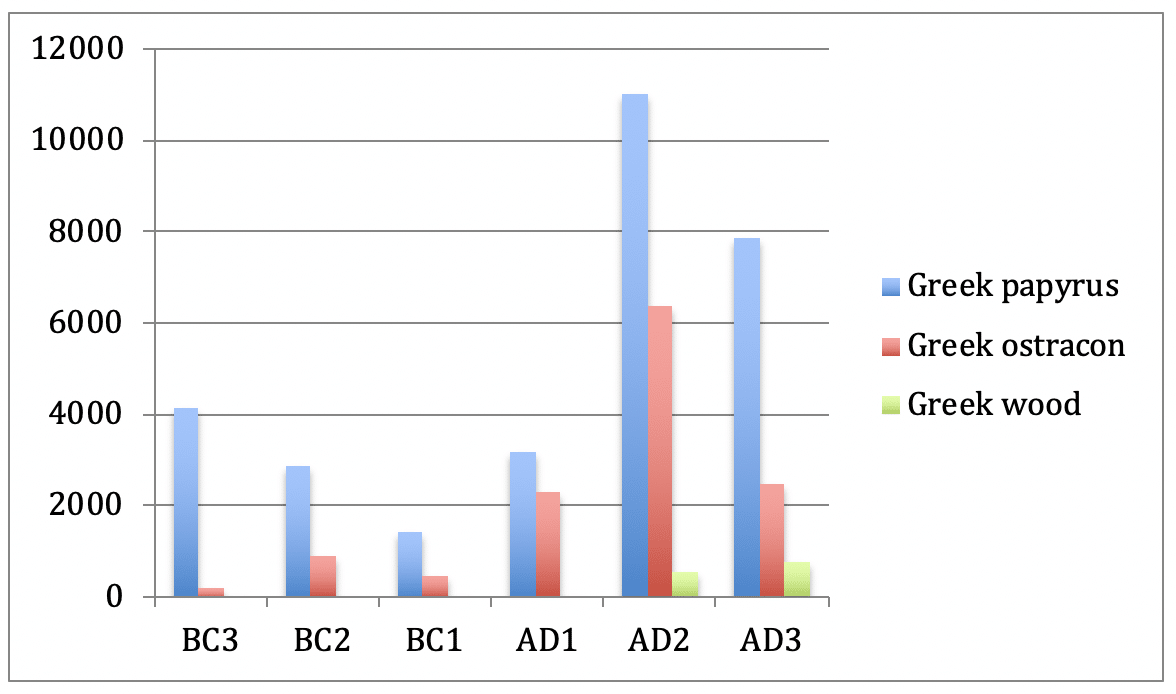
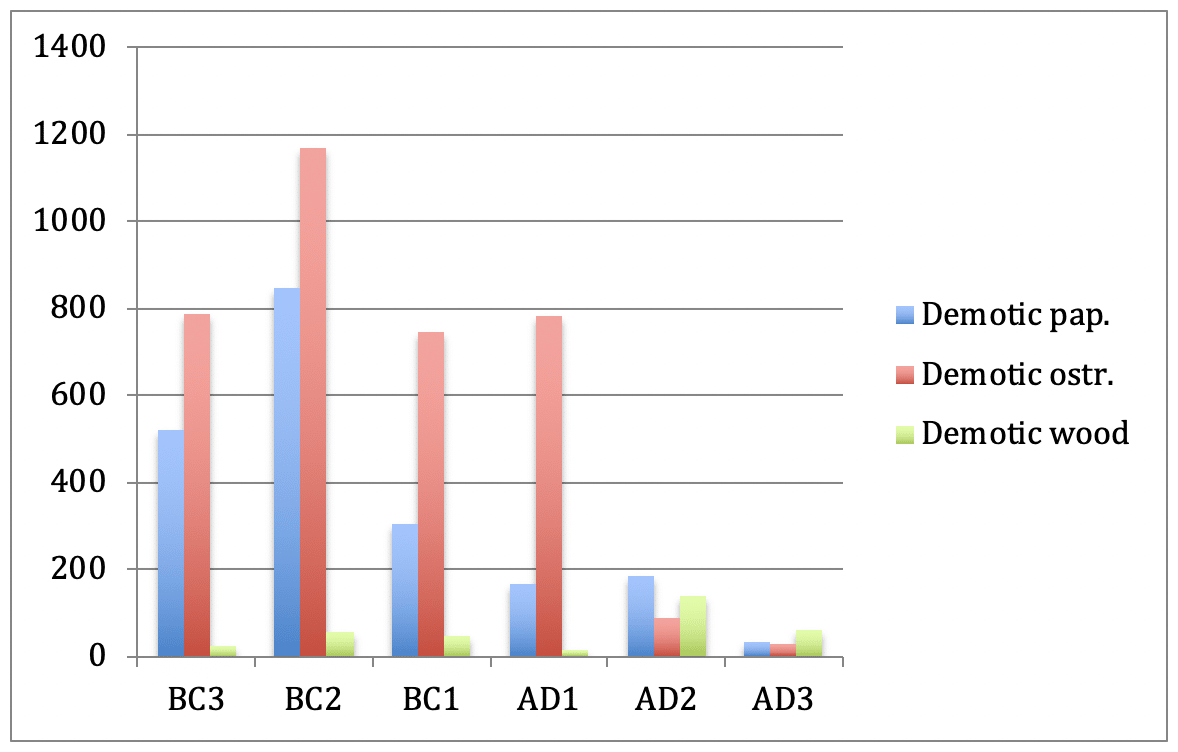
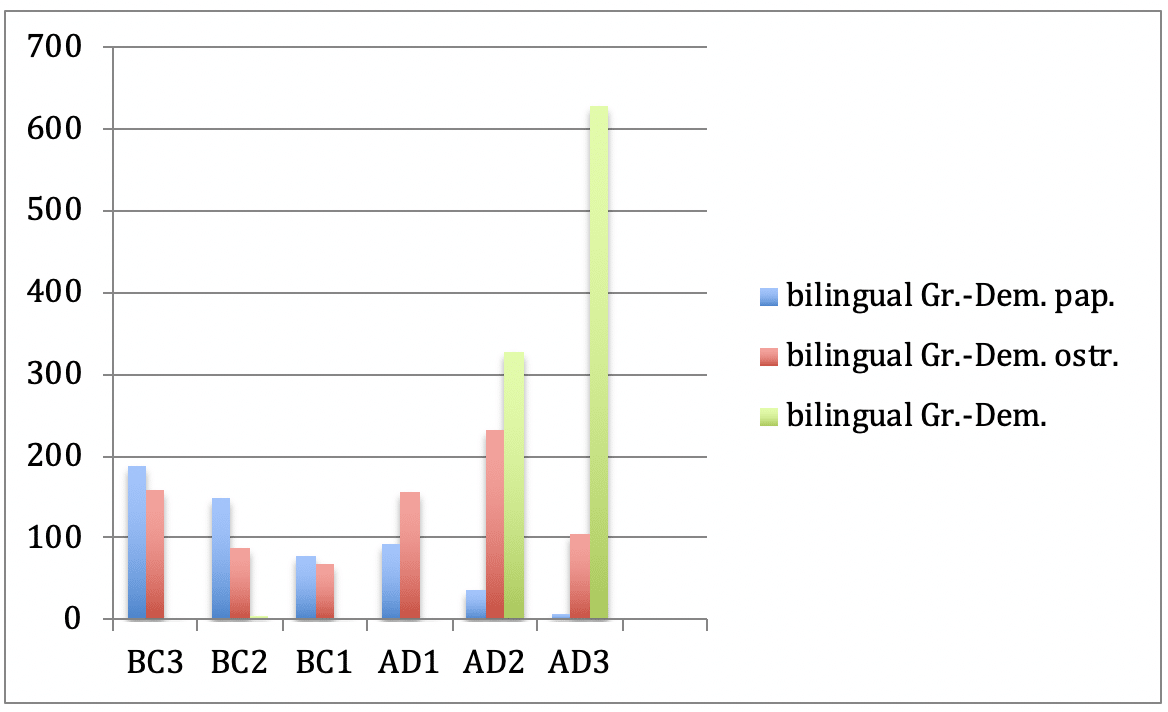
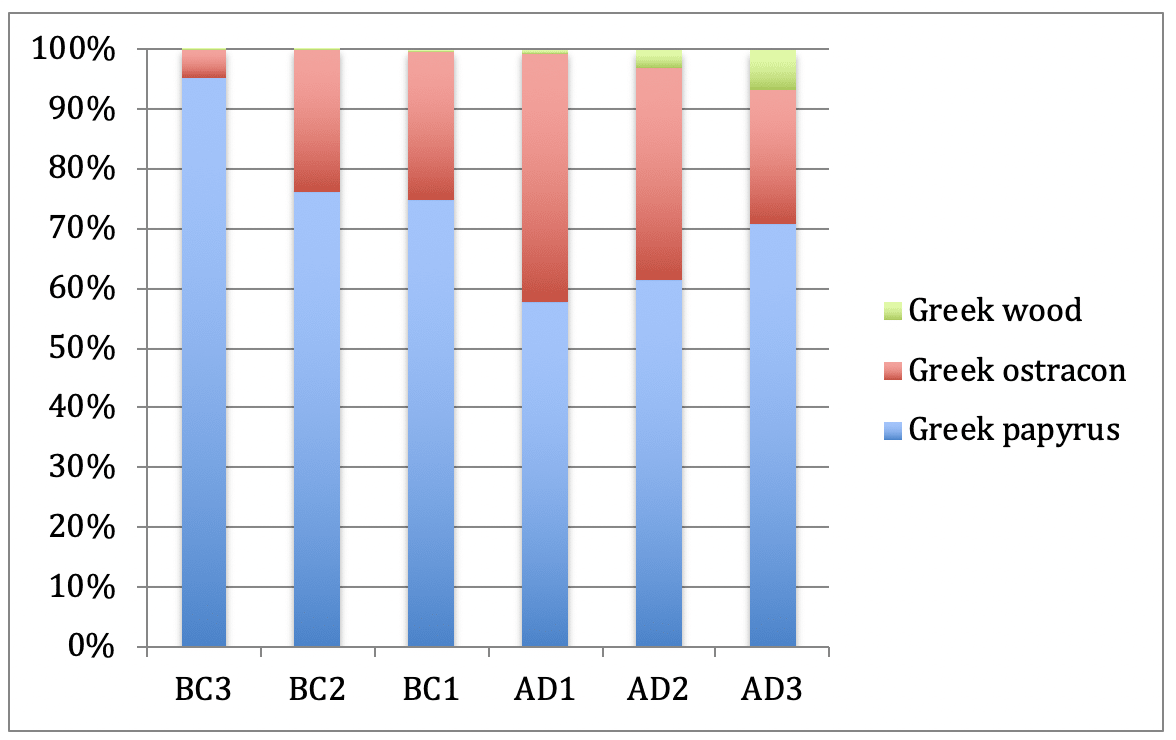
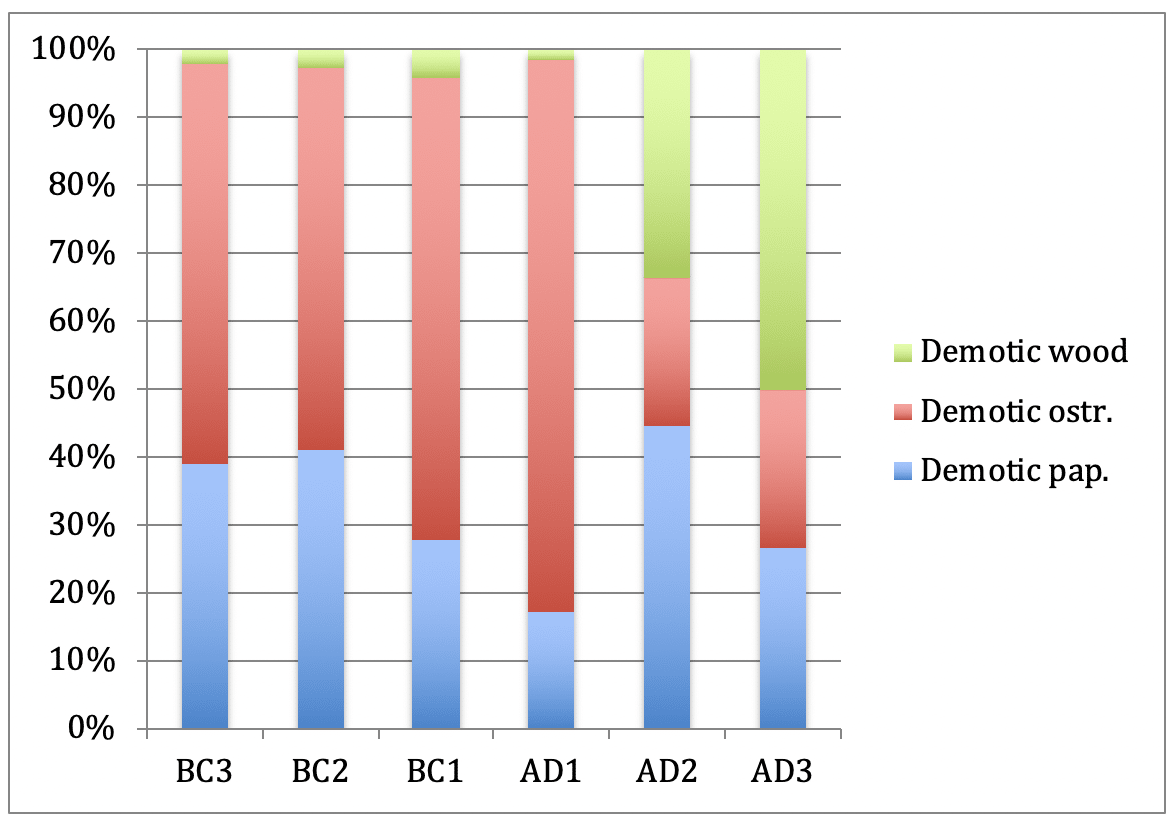
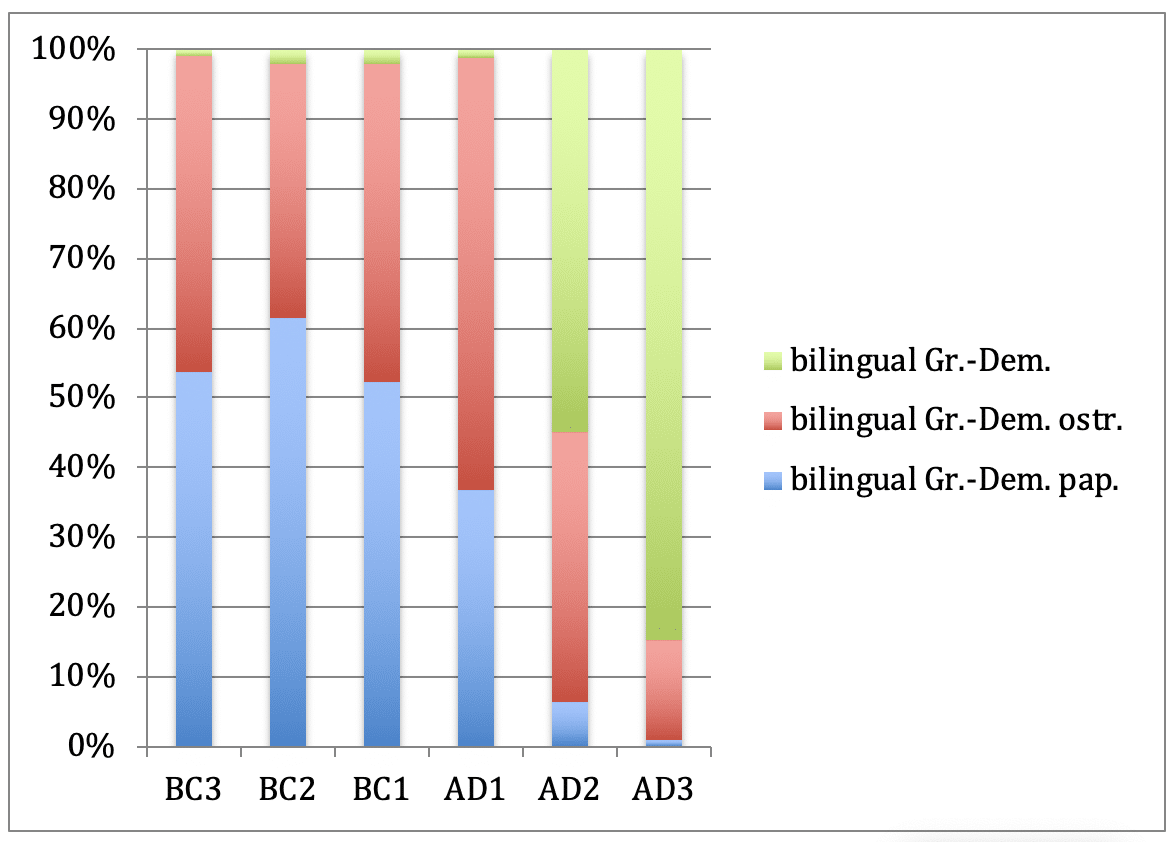
Types of bilingual documents
Greek and demotic may be equal partners, a primary Greek text may be accompanied by a demotic text or a primary demotic text may be accompanied by a Greek text.
The two languages are equal
1a. The two texts provide the same message, with minor differences, as in the following cases4:
- The famous trilingual decrees may be adduced here as an example outside the papyrological documentation5. Eleven of these priestly decrees are preserved, some in different copies. There has been much discussion as to which was the original language; in my view these are Greek honorary decrees, written by the corporation of Egyptian priests, who take over the function of the Greek city states found in other Hellenistic kingdoms6.
- In the mummy labels, Greek and demotic are also presented on an equal footing. They contain the name and identification (patronymic, metronymic, place of origin) of the deceased. The demotic side usually also carries a religious formula, which is rare in the Greek texts. With the recent publications of Arlt (2011) and Vleeming (2011) more than 1600 mummy labels are now published, most of them dated to the second and/or the first part of the third century. Though mummification was a typically Egyptian priestly business, purely demotic tags are rather rare. More than half of the labels are bilingual.
- Other texts where the two languages stand side by side are rare. We do have some cases of a Greek text with translation in demotic or vice versa, but written on different sheets of papyrus. Since these are treated as separate documents in the database, they do not appear as bilinguals (e.g. P.Eleph. 27; O.Hor A-E; P.Choach.Survey 17 A and B, now republished by Mairs, Martin (2008)). In the bilingual ostracon SB 24 16083 the texts are nearly identical, though the demotic offers a few extra details. On the other hand, the Greek is written on the outside of the pot, and this is normally the first writing surface. Here again the two texts are apparently on the same level.
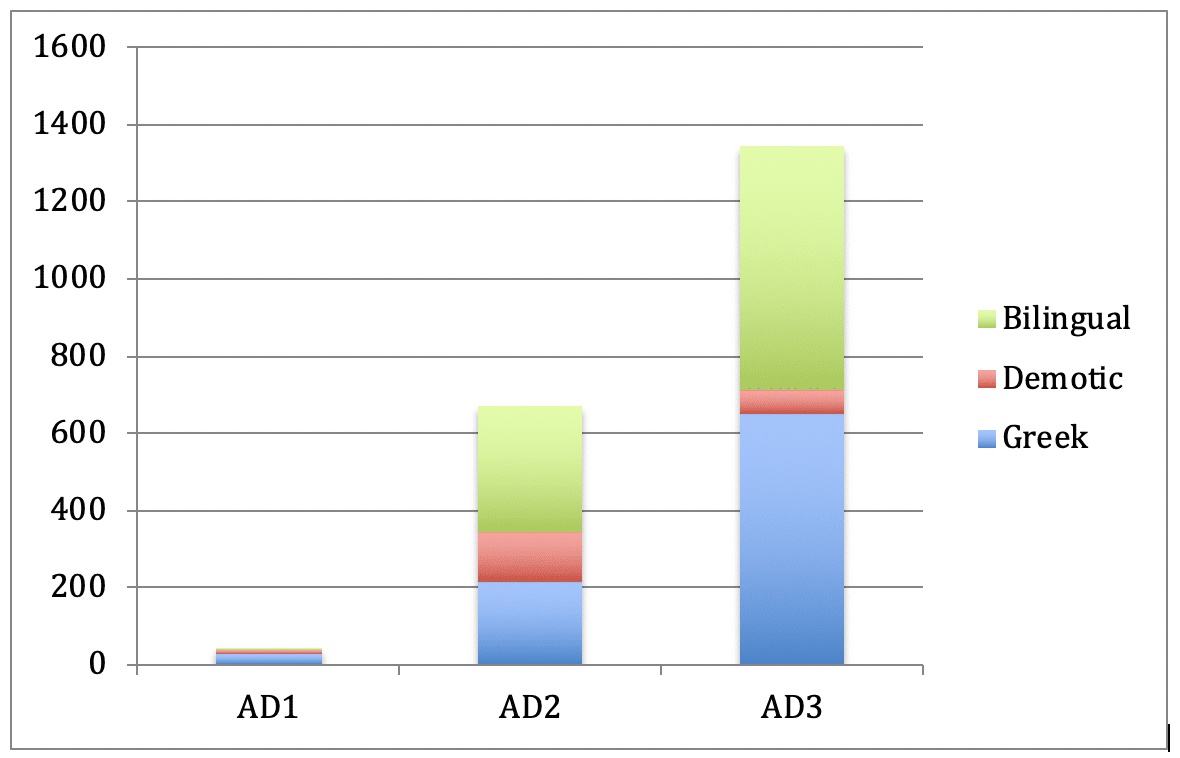
1b. Continuation:
- P.Count 2 (229 BC) is a long demotic list of persons who are liable to the salt tax. No more than 30 cm is preserved of this list, which enumerated more than 11,000 persons by name ordered by village, by occupation and by family. After each village came the totals for each occupation. These totals, without the names of the taxpayers, were then copied in Greek on the verso of the papyrus (P.Count 3). There were some 35 villages in 5 districts; we have the (partial) totals of two districts only, divided by villages. After these Greek totals by district, the scribe continued with totals for the whole area, divided by districts now, but for this he unexpectedly returned to demotic (P.Count 2 ll. 441-537 to which a large new fragment has now been added in Clarysse, Thompson (2018)). Here we see the bilingual administration at work. In the end, the final report had to be sent to the central administration in Krokodeilon polis and on to Alexandria and there can be no doubt that at this stage the presentation was again in Greek. The account on an ostrakon from Aswan [TM 25311], discussed by Mairs (2012), is similar (demotic is used for individual entries, Greek for totals), although in that case the demotic precedes the Greek.
- SB 28 16943 is a private letter which starts in Greek and continues in demotic, but the relation between the two parts is unclear. In O.Mich. 2 754 too Greek and demotic seem to alternate (see now ZPE 191, 2014, p. 228), as also in the account P.Brookl. 81 (demotic still unpublished).
- In the early Roman period there are several examples of demotic sales preceded by a Greek contract of loan, written by the notary in the third person, and followed by a Greek autograph subscription by one of the parties (see for this below sub 3b). The demotic sale and the Greek loan together apparently constitute “two phases of a form of hypothecation, an ὠνὴ ἐν πίστει7” and the Greek loan contract is therefore continuation of the demotic sale and cession.
- In the ostraca from Narmouthis one finds a remarkable shift from Greek to Egyptian, even within a single text8. Most texts are either Greek with some demotic or demotic with some Greek and are therefore to be found in the next section, but the archive as a whole is a rare example of a complete linguistic mixture. Sometimes a Greek word is inserted into a demotic text or sometimes the other way round. This was not easy for the scribes because the two scripts run in different directions. Many demotic ostraca contain just a serial number in Greek yet they still count as demotic-Greek.
2 and 3) Bilingual texts where either Greek or demotic are primary
| BC3 | BC2 | BC1 | AD1 | AD2 | AD3 | |
| Gr./dem. | 163 | 177 | 39 | 127 | 128 | 22 |
| Dem./Gr. | 174 | 123 | 103 | 113 | 143 | 111 |
Primary Greek with a secondary demotic text [881 items]9
2a. Greek texts with a demotic summary
- Greek receipts in the form of double documents with full demotic text written in the first person by one of the parties, e.g. P.Lugd.-Bat. 20 1-7 (Zenon archive). In Enchoria 16 (1988), p. 14 [= SB 20 14430 for the Greek] the surety repeats the main points of the contract in the first person (though in fact the demotic is written by a scribe)10.
- Numerous Greek tax receipts are followed by a demotic summary, which may include the name of the taxpayer, the type of tax, the amount paid, the date and/or the name of the scribe. Many examples are found on Theban ostraca (see e.g. O.Varia and O.Taxes II passim), but there are also instances on papyrus, as in the Taembes archive (Clarysse (2007)). In other cases, different scribes each give their name (“signature”, followed by the date and the amount paid. In the second century AD, short demotic subscriptions are often linked to taxpayers of a few priestly families in Thebes11.

2b. Demotic signature
- Demotic autograph signatures in the first person under Greek texts are rather exceptional, e.g. in P.Eleph. 27a, a Greek letter to the praktor Milon from three brothers who are priests and who sign in demotic, or P.Mich. V 226, a Greek petition to the strategos by three priests from Tebtynis, who put their signature below the Greek text12. In BGU 19 2761 (52 BC) an ibis priest with the Greek name Leon signs in demotic.
- Signatures of Egyptian scribes under a Greek text, without further details (e.g. O.Varia 27; O.Taxes II 47; 103; O.Strasb. 779) represent a minimal form of summary as treated under 2a.
2c. For filing purposes
A few Greek contracts receive an archival note in demotic appended by one of the parties, either at the foot of a document or on the back. This form of private filing was studied by Pestman (1985), p. 40-42 and by K. Vandorpe in P.Bingen, p. 198-199. Sometimes a one-word summary identifies the type of document (as in ZPE 121, 1998, p. 197-198) or the subject matter (P.Köln 8 347: “matters of the king”). When a tax receipt on a Greek ostrakon has a single line with just the name of the taxpayer, this could also have been used for filing, e.g. O.Leid. 62; 204; SB 16 12884-12887.
2d. The demotic text following the Greek is sometimes a different transaction related to the main transaction in Greek. Thus, the Greek loans P.Grenf. 1 28 and P.Dryton 29 are followed by a demotic receipt, confirming that the loan was repaid13.
Primary Demotic and secondary Greek text [819 items]14
3a. Demotic text with a Greek summary
- Greek summaries written under or on the back of demotic texts received by administrative offices were probably also used for filing (see 3c).
Surety contracts for brewers, oil sellers and a few other monopolistic trades with the oikonomos and the topogrammateus (P.LilleDem. I passim; TM 4294) were written as demotic double documents, and received a Greek abstract on the back. Sometimes the Greek was written with a reed kalamos, sometimes with an Egyptian brush15. Letters and oaths in the archive of the nomarch Aristarchos16 and declarations of cattle in the archive of his colleague Diogenes17 often have Greek summary at the foot (cf. also UPZ 186). In the archive of the praktor Milon similar abstracts were added under a demotic petition (mqmq), an offer by priests to lease land and an oath.18 - Demotic tax receipts with Greek summary. In the third century BC summaries were often written with an Egyptian brush; these may have been added by the scribe who wrote the demotic, as in the example (fig. 9).
- Signature of a Greek scribe at the foot of a demotic ostrakon, e.g. O.Med. Habu 67, with the note of R. S. Bagnall in Enchoria 8.1 (1978), p. 146 or SB 16 12409, 12872, 12875 and 12877.

3b. Greek statement by one of the parties
- In a few demotic notarial contracts of the later Ptolemaic period the first party has subscribed a promissory note (“I agree that I will do according to what is written above”)19. This type of subscription is common in Greek beneath Greek cheirographa and in demotic beneath demotic contracts (already before the arrival of the Greeks). But Greek subscriptions under demotic contracts, certainly made by bilingual persons, remain exceptional (Depauw 2009, 132-133 counts only 9 of them).
- In the early Roman period, however, the first party of any notarial contract, Greek or demotic, had to add a far more elaborate Greek subscription in the first person (termed an “autograph”, although usually the text was written by a third person). Depauw has collected about 25 demotic contracts with such subscriptions dating from between 12 BC and AD 71, all from the Fayum area (Dime and Tebtynis)20. Sometimes the second party also wrote his version of the contract, though this second copy could also be in demotic and was not obligatory. From this period on demotic contracts were only registered when accompanied by a Greek autograph subscription, which made the demotic superfluous for legal documents. By the end of the first century AD demotic was no longer used for notarial contracts.
3c. Filing of documents
- In government offices: in P.Teb. I 228 and pTebt. UC inv. 2489, discussed by Muhs (2010), 583-584, a Greek scribe adds on the back that the main text is written “in Demotic (ἐνχωρίοις γράµµασι”; the Greek summaries mentioned in 3a above probably also functioned for filing purposes. Similarly, the banker Menodoros adds the name of the taxpayer in Greek in the margins of his demotic receipts (see below, “the end of demotic”).
- In private archives: a demotic loan in the Dryton archive (171 BC) contains a Greek summary by Dryton on the verso [P.Dryton 12; see also P.Dryton 20]
- A summary of just the name of a party (as in P.Ehevertr. 28 + SB 18 13085: Τεννησι; UPZ 2 178: Ὧρος Ὥρου; cf. also SB 18 13565-13572) may have been written by the notary, who may have had two copies at his disposal, one for each of the two parties21. The same practice is found on ostraca e.g. O.Strasb. 56; 84; 88.
3d. Greek texts written later below demotic contracts (“pseudo-bilinguals”)
Demotic contracts with a Greek registration note. From 259 to 240 BC a dozen demotic contracts bear a Greek subscription, usually beginning with πέπτωκεν εἰς κιβωτόν, indicating that the contract was deposited in the nome archive22. In 145 BC a new rule is established that all demotic contracts should receive a Greek subscription (ὑπογραφή) with the date, the name of the parties and a record of the type of contract23. This is found below all demotic notarial contracts of the later 2nd and 1st centuries BC24.
In demotic notarial contracts of sale a Greek docket at the foot of the text records the payment of the sales tax (enkyklion) has been paid. Like the preceding registration note this is a later addition to an originally unilingual demotic contract25

The end of demotic
In Theban tax receipts of the early Roman period the demise of demotic can be followed in detail. The receipts were usually written in demotic up to AD 31, when Greek receipts come to the fore, a quarter of which carry demotic subscriptions. From AD 32 to 43 demotic receipts appear only sporadically and they disappear completely after AD 43. The bankers in this period are members of the same extended family, but some write mostly in demotic, others mostly in Greek26. Thus, Menodoros writes 36 demotic receipts compared to a single Greek one, but in ten cases he adds the name of the taxpayer in Greek in the margin, perhaps for filing purposes (see above).
The last demotic inscriptions are two graffiti at Philae, dated in AD 45227, but Philae is an exception and elsewhere demotic disappeared long before28. The last dated papyrus document is Chrest.Wilck. 86, a bilingual receipt for linen for the mummification of the sacred Apis bull (AD 210/211), except for an illegible note on CPR 17/2 13 (AD 217) and an unpublished papyrus in a private collection, attributed to AD 260 (TM 109234). The last bilingual ostraca are P.Zauzich 33 and 34 (AD 203/204) and O.Zürich 54 (AD 223 according to Bagnall (1978), 147-149)29. A few bilingual mummy labels are dated to the second half of the third century30.
Bibliography
- Arlt, C. (2011): Deine Seele möge leben für immer und ewig. Die demotischen Mumienschilder im British Museum, StudDem 10, Leuven-Paris-Walpole MA.
- Ast, R. et al., ed. (2013): Papyrological texts in honor of Roger S. Bagnall, American Studies in Papyrology 53, Durham.
- Bagnall, R.S. (1978): “Notes on Greek and Egyptian ostrakaˮ, Enchoria, 8.1 (1978), 143-150.
- Baetens, G. and Angles, P.-L. (2018): “A demotic memorandum to the village epistates with a Greek subscriptionˮ, Chron. d’Ég., 93, 281-293.
- Blasco, A. (2015): “Le bilinguisme gréco-égyptien dans les ostraca de Narmouthisˮ, Chron. d’Ég., 90, 350-359.
- Blasco, A. (2018): “La chronologie des archives de Narmouthisˮ, Ancient Society, 48, 199-219.
- Bussi, S., ed. (2013): Egitto dai faraoni agli Arabi, Atti del Convegno Egitto, 7-9 gennaio 2013, Studi ellenistici Suppl. 1, Pise – Rom.
- Clarysse, W. (2000): “Ptolémées et templesˮ, in: Valbelle & Leclant, ed. 2000, 41-65.
- Clarysse, W. (2007): “The archive of Taembes, a female brewer in the Heracleopolite nomeˮ, Ancient Society, 37, 89-95.
- Clarysse, W. (2010): “Bilingual papyrological archivesˮ, in: Papaconstantinou, ed. 2010, 47-72.
- Clarysse, W. (2013): “The use of Demotic in the Ptolemaic administrationˮ, in : Bussi, ed. 2013, 69-79.
- Clarysse, W. (2015): “Filiation the Egyptian way in Greek documentsˮ, Lingua Aegyptia, 23, 277-282.
- Clarysse, W. and Thompson, D.J. (2018): “P. Count 2 continued: a population register from the Arsinoite nomeˮ, in: Donker van Heel et al., ed. 2018, 162-189.
- Démare-Lafont S., ed. (2019): Debt in Ancient Mediterranean Societies, Hautes Études Orientales 56, Genève.
- Depauw, M. (1997): A companion to Demotic studies, Papyrologica Bruxellensia 28, Bruxelles.
- Depauw, M. (2003): “Autograph confirmation in demotic private contractsˮ, Chron. d’Eg., 78, 66-111.
- Depauw, M. (2009): “Bilingual Greek-demotic documentary papyri and hellenization in Ptolemaic Egyptˮ, in: Van Nuffelen, ed. 2009, 113-146.
- Donker van Heel, F. et al., ed. (2018): Hieratic, Demotic and Greek Studies and Text Editions. Of Making Many Books There is No End: Festschrift in Honour od Sven Vleeming, P.Lugd.-Bat. 34, Leiden – Boston.
- Fournet, J.-L. (2018): “Les documents bilingues gréco-coptes dans l’Égypte byzantine: essai de typologieˮ, in : Lafkioui & Brugnatelli 2018, 59-83.
- Lafkioui, M. and Brugnatelli, V. (2018): Written sources about Africa and their study, Africana Ambrosiana 3.
- Lippert, S.(2019): “Demotic Loans with mortgage in their legal-historical contextˮ, in: Démare-Lafont, ed. 2019, 123-152.
- Mairs, R. and Martin, C.J. (2008-2009): “A bilingual sale of liturgies from the archive of the Theban choachytes: P. Berl. 5507, P. Berl. 3098 and P. Leid. 413ˮ, Enchoria, 31, 22-67.
- Mairs, R. (2012): “Bilingual tagging of financial accounts in Demotic and Greekˮ, ZÄS, 139, 37-44.
- Moje, J. (2012-2013): “Schrift- und Sprachwahl bei epigraphischen Triskripten des griechisch-römischen Ägypten mit einem demotischen Textteilˮ, Journal of the Society for the Study of Egyptian Antiquities, 39, 87-123, [online] https://www.academia.edu/9467983/_Schrift_und_Sprachwahl_bei_epigraphischen_Triskripten [consulted on 04/04/2023].
- Muhs, B. (2010): “A Late Ptolemaic grapheion archive in Berkeleyˮ, in: Proceedings of the 25th international congress of papyrology, American Studies in Papyrology, Ann Arbor, 581-588.
- Papaconstantinou, A., ed. (2010): The multilingual experience in Egypt, from the Ptolemies to the Abassids, Farnham.
- Pestman, P.W. (1985): Textes et études de papyrologie grecque, démotique et copte, P.Lugd.-Bat. 23, Leiden, 23.
- Pestman, P.W. (1993): The archive of the Theban choachytes. A survey of the Demotic and the Greek papyri contained in the archive, StudDem 2, Leuven.
- Richter, T.S. (2013): “O. BM EA 20300: In search of the latest dated Demotic ostraconˮ, in: Ast et al., ed. 2013, 285-290, [online] https://www.academia.edu/17927180/O_BM_EA_20300_In_search_for_the_latest_dated_Demotic_ostracon [consulted the 04/03/2023].
- Valbelle, D. and Leclant, J., ed. (2000): Le décret de Memphis, Colloque de la Fondation Singer-Polignac à l’occasion de la célébration du bicentenaire de la découverte de la Pierre de Rosette, Paris.
- Vandorpe, K. and Clarysse, W. (2008): “Egyptian bankers and bank receipts in Hellenistic and early Roman Egyptˮ, in : Verboven et al., ed. 2008, 153-168.
- Van Nuffelen, P., ed. (2009): Faces of hellenism. Studies in the history of the eastern Mediterranean, StudHell 48, Leuven.
- Verboven, K. et al., ed. (2008): Pistoi dia tèn technèn. Bankers, Loans and Archives in the Ancient World. Studies in Honour of Raymond Bogaert, StudHell 44, Leuven.
- Vleeming, S. (2011): Demotic and Greek-demotic mummy labels and other short texts gathered from many publications, Short Texts II, StudDem 9, Leuven-Paris-Walpole MA.
- Winkler, A.F. and Zellmann-Rohrer, M. (2016): “A bilingual petition from the priests of Roman Tebtynis: P. Mich. V 226 once againˮ, ZPE, 197, 195-203.
- Wolff, H.-J. (1978): Das Recht der griechischen Papyri Aegyptens, Handbuch der Altertumswissenschaft 5.2, Munich.
Notes
- Note des éditeurs : “cet article a été écrit dans le câdre du projet GESHAEM. Ce projet est subventionné par le European Research Council (ERC) sous le programme “Horizon 2020 recherche et innovationˮ (grant agreement No 758907) de la communauté européenne”.
With thank to D.J. Thompson, who checked my English and saved me from a few glaring errors and to Mark Depauw, who made several useful suggestions on an earlier draft. For the abbreviations in papyrological editions, see https://papyri.info/docs/checklist. Our definition of “bilingual texts” follows that of DEPAUW 2009, 114-115 : “Greek and demotic are both used on a single writing surface and there is an intentional relation between the texts using these different languages and scripts.” The figures were established in 2016 and have not been changed. - Here and in the following tables all texts have been selected as follows 1) texts dated within one century, 2) texts dated over two centuries counting half for one and half for the other century. Literary texts (all those included in the Leuven Database for Ancient Books), inscriptions and texts dated over a broader range than two centuries (e.g. numerous unpublished ostraca in the British Museum) have been excluded.
- For demotic and bilingual mummy labels, see now Vleeming (2011).
- For other cases where Greek and demotic alternate in the same text, but often with priority for one language over the other, see Depauw (2009),119-120, with a list on p. 132.
- For trilingual decrees in general, see most recently Moje (2012-2013).
- Clarysse 2000.
- Cf. P.Ryl. Gr. 2 160c introd., BGU 13 2337 and P.Dime 3, p. 50-55; see also Depauw (2003), 110-111. For these types of documents, see now Lippert 2019, 123-152 (esp. p. 133-136).
- For a recent survey of this dossier, see Blasco 2015 and Blasco 2018.
- Texts where Greek and demotic are on the same level, marked as “parallel” under language 2, have been excluded.
- Depauw 2009, 133-136 treats this group together with the “demotic signatures” which we deal with under 2b.
- See the discussion by P. Heilporn in O.Strasb. 2, pp. 138-146.
- The text has been reedited, with several corrections and a full commentary by Winkler, Zellmann-Rohrer 2016. For a survey of similar cases, see Depauw 2003, 90 n.161, to which SB 18 16362 may now be added.
- For more examples, see Depauw 2009, 145-146. Some of his examples I would classify rather as summaries.
- Because from the later Ptolemaic period onwards demotic contracts are often accompanied by a Greek subscription or archival notice most demotic archives have a Greek component, even when notes of registration and receipts for the sales tax are not taken into account, see Clarysse 2010.
- For a full list of this group, see Depauw 2009, 1367-141. A new edition of these “cautionnements démotiques” is being prepared by W. Clarysse and M.-P. Chaufray; see e.g. Clarysse 2013, 71-73.
- P.Sorb. 3 76; 78; 81; 83; P. Sorb. inv. 2735a, 747 and 749 ined. (to be published by W. Clarysse)
- P.LilleDem. 1 12; 13; 17; 19; 20; SB X 10452; Enchoria 8.2 (1978), p. 2. A new edition of the bilingual texts is being prepared by S.P. Vleeming.
- P.Eleph. 16; 6; 7; 26. See now also Baetens, Angles 2018.
- Depauw 2003, 66-88.
- Depauw 2003, 89-105; see now P.Dime 3, 4-5, 40-50 and 55-58.
- Examples are P.Ehevertr. 28 + SB 18 13085 (Τεννησι); UPZ II 178 (Ὧρος Ὥρου); P.Lugd.-Bat 22 7, with note o by the editor.
- A list is given by U. Wilcken in UPZ I, 603-604, with full discussion; add e.g. P.Chic.Haw. 6, 9 and Appendix; P.Hawara 1-3.
- The standard publication of the basic text (TM 3543) is that by U. Wilcken in UPZ I, 596-597.
- Wolff 1978, 169-173; Pestman 1993, 337-341.
- For examples of a sale tax receipt under demotic documents, see UPZ 2 163-188 passim, discussed by Pestman 1993, 353; P.Tor.Botti 3; 7; 12; SB 1 5729 (under P.Brit.Mus. 4 27). In one case a demotic tax receipt follows upon a Greek notarial contract, see P.Lugd.-Bat. 19, p. 219-221.
- Vandorpe, Clarysse 2008, 166-168.
- Graff. Dodec. Philae 365 and 377.
- The next paragraph is an update of the excellent survey by P. Heilporn in O.Strasb. 2, p. 133-137; see also Depauw 1997, 25.
- O. Brit. Mus. inv. 20.300 was attributed to AD 232/233. This was rightly doubted by Heilporn, p. 135. The text is now published by T.S. Richter as P.Bagnall 49 and dated to the first or second cent. AD.
- Short Texts 2 831 (AD 256), CEML 835 (AD 260/261), 846 (AD 268 ?), CEML 131 (AD 273; demotic unpublished) and 883 (AD 302 ?); see the palaeographical discussion in Vleeming (2011), 810-812.


